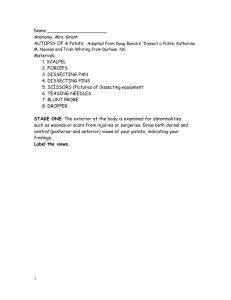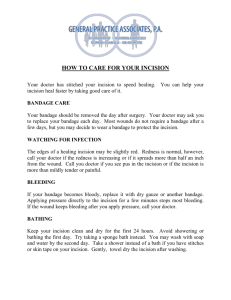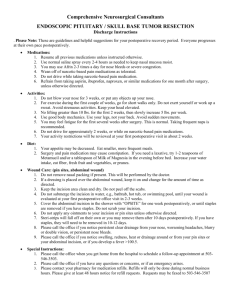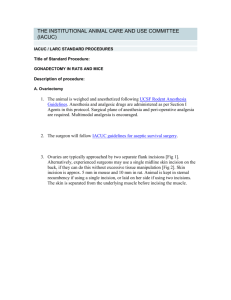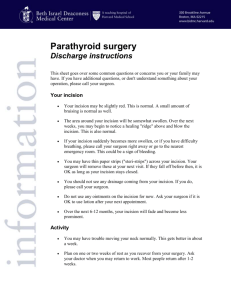Surgical Procedures Description and Guidance
advertisement
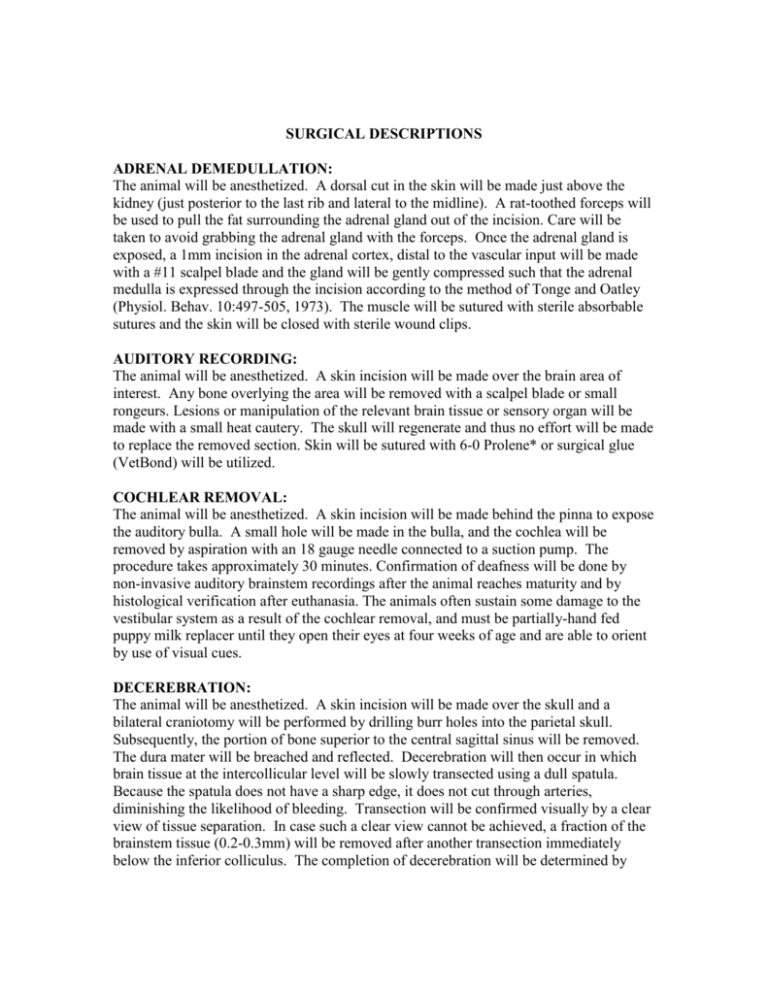
SURGICAL DESCRIPTIONS ADRENAL DEMEDULLATION: The animal will be anesthetized. A dorsal cut in the skin will be made just above the kidney (just posterior to the last rib and lateral to the midline). A rat-toothed forceps will be used to pull the fat surrounding the adrenal gland out of the incision. Care will be taken to avoid grabbing the adrenal gland with the forceps. Once the adrenal gland is exposed, a 1mm incision in the adrenal cortex, distal to the vascular input will be made with a #11 scalpel blade and the gland will be gently compressed such that the adrenal medulla is expressed through the incision according to the method of Tonge and Oatley (Physiol. Behav. 10:497-505, 1973). The muscle will be sutured with sterile absorbable sutures and the skin will be closed with sterile wound clips. AUDITORY RECORDING: The animal will be anesthetized. A skin incision will be made over the brain area of interest. Any bone overlying the area will be removed with a scalpel blade or small rongeurs. Lesions or manipulation of the relevant brain tissue or sensory organ will be made with a small heat cautery. The skull will regenerate and thus no effort will be made to replace the removed section. Skin will be sutured with 6-0 Prolene* or surgical glue (VetBond) will be utilized. COCHLEAR REMOVAL: The animal will be anesthetized. A skin incision will be made behind the pinna to expose the auditory bulla. A small hole will be made in the bulla, and the cochlea will be removed by aspiration with an 18 gauge needle connected to a suction pump. The procedure takes approximately 30 minutes. Confirmation of deafness will be done by non-invasive auditory brainstem recordings after the animal reaches maturity and by histological verification after euthanasia. The animals often sustain some damage to the vestibular system as a result of the cochlear removal, and must be partially-hand fed puppy milk replacer until they open their eyes at four weeks of age and are able to orient by use of visual cues. DECEREBRATION: The animal will be anesthetized. A skin incision will be made over the skull and a bilateral craniotomy will be performed by drilling burr holes into the parietal skull. Subsequently, the portion of bone superior to the central sagittal sinus will be removed. The dura mater will be breached and reflected. Decerebration will then occur in which brain tissue at the intercollicular level will be slowly transected using a dull spatula. Because the spatula does not have a sharp edge, it does not cut through arteries, diminishing the likelihood of bleeding. Transection will be confirmed visually by a clear view of tissue separation. In case such a clear view cannot be achieved, a fraction of the brainstem tissue (0.2-0.3mm) will be removed after another transection immediately below the inferior colliculus. The completion of decerebration will be determined by visual inspection of the brain tissue with respect to the complete separation of the brainstem from the upper levels of brain tissues. Once the animal is decerebrated, the animal will no longer be able to detect a pain sensation. At this time, the anesthesia will be terminated and the animal will be maintained on a paralytic agent such that it will be unable to move. At the termination of the experimental procedures, the animal will be euthanized without recovery from the influence of the paralytic. SURGICAL DENERVATION OF ADIPOSE TISSUE: The animal will be anesthetized. The incision site for the denervation depends on the fat pad to be denervated. A small skin incision will be made. The epididymal white adipose tissue (WAT) denervation requires a ventral incision that invades the peritoneal cavity. The inguinal WAT denervation requires only a ventral incision along the rear dorsal flank, as this is a subcutaneous fat pad. The retroperitoneal WAT denervation requires a dorsal incision slightly more anterior to the inguinal cut, but invades the peritoneal cavity as this is an internally located WAT pad. The nerves will be cut with microscissors with the aid of a dissecting microscope as they enter the fat pads. The skin will be closed with sterile absorbable sutures and the incision will be closed with wound clips. CHEMICAL DENERVATION OF ADIPOST TISSUE (6 OHDA): The animal will be anesthetized. We will sympathetically denervate white adipose tissue (WAT) using local injections of the catecholamine neurotoxin 6-hydroxy-dopamine (6OHDA). The incision site for the denervation depends on the fat pad to be denervated. A small skin incision will be made. The epididymal white adipost tissue (WAT) denervation requires a ventral incision that invades the peritoneal cavity. The inguinal WAT denervation requires only a ventral incision along the rear dorsal flank, as this is a subcutaneous fat pad. The retroperitoneal WAT denervation requires a dorsal incision slightly more anterior to the inguinal cut, but invades the peritoneal cavity as this is an internally located WAT pad. The WAT or BAT pad will be injected with micro amounts and volumes of the 6OHDA (Sigma Chemical, St. Louis, MO; 10 injections of 1 microliter of 4mg/100 microliter 6OHDA in sterile saline per fat pad). The incision will be closed with wound clips. In some cases where we are testing for overall effects of denervation on systems physiology and/or behavior, we use a between animals design so this will be done bilaterally with a separate group receiving saline control injections. In other cases, we are looking at the effects of denervation on a fat pad response to be contrasted with the response on the opposite side. In this case the contralateral fat pad receives similar injections of the saline vehicle. As these are relatively small volumes in such large target tissues, the toxin does not escape into neighboring tissues. Note that 6OHDA is not an IBC regulated toxin and is safe to handle. We do, however use the same precautions as with real toxins: 1) injections will be done in a safety hood with the individual performing the injections wearing gloves, mask, lab coat and goggles, and 2) all materials will be autoclaved after use. CHEMICAL DENERVATION OF ADIPOST TISSUE (Capsaicin): The animal will be anesthetized. We will sympathetically denervate adipose tissue using local injections of capsaicin, the pungent part of red chili peppers. Capsaicin kills small unmyelinated sensory neurons. Although many have injected capsaicin systemically to produce a global peripheral sensory denervation, we will use it to produce a local selective sensory denervation of white adipose tissue (WAT) or of brown adipose tissue (BAT). The incision site for the denervation depends on the fat pad to be denervated. A small skin incision will be made. The epididymal WAT denervation requires a ventral incision that invades the peritoneal cavity. The inguinal WAT denervation requires only a ventral incision along the rear dorsal flank, as this is a subcutaneous fat pad. The retroperitoneal WAT denervation requires a dorsal incision slightly more anterior to the inguinal cut, but invades the peritoneal cavity as this is an internally located WAT pad. The pad will be visualized and the injections will be made to cover the pad. Capsaicin (Sigma) will be injected locally as 20 microinjections (2 microliters per injection, 40ul total) of 200 micrograms/microliter of capsaicin dissolved in a sterile vehicle consisting of 10% of ethanol, 10% of Tween 80 and 80% of 0.9% NaCl using a microsyringe. The incision will be closed with sterile wound clips. In some cases where we are testing for overall effects of denervation on systems physiology and/or behavior, we use a between animals design so this will be done bilaterally with a separate group receiving saline control injections. In other cases, we are looking at the effects of denervation on a fat pad response to be contrasted with the response on the opposite side. In this case the contralateral fat pad will receive similar injections of the saline vehicle. Note that capsaicin will be used to alleviate pain. Also note that capsaicin is being injected directly into tissue and will be done in such a way as to minimize if not prevent leakage outside of the tissue. Capsaicin also does not require IBC approval. The experimenter, however, will mix the solution in a biological safety cabinet and will also don gloves, a lab coat, and eye protection. ELECTROPHYSIOLOGY: The animal will be anesthetized. This procedure will be conducted to explore the response of individual neurons in the auditory cortex to auditory or visual stimulation. The head will be stabilized in a stereotaxic head holder. The animal will be paralyzed with gallamine triethiodide (to eliminate eye movements) if necessary (this is not expected) but at any rate will be artificially respired at a rate of 30-40/min. In the case of paralysis, withdrawal reflexes cannot be used as an indication of pain and heart rate will be used to assess the depth of anesthesia. The cortex will then be exposed unilaterally by making a C-shaped incision in the scalp and performing a craniotomy and durotomy over the region of interest. The brain tissue will be protected throughout the procedure by covering it with warm mineral oil or 1% agar in saline. Extracellular multiunit recordings will be made with tungsten microelectrodes. By making tracer injections before or during the electrophysiology, the physiology can be directly correlated with the connectivity, reducing the number of animals needed. The bladder will be emptied at intervals by gentle manual pressure so that the animal remains clean and dry. Auditory stimuli stereo headphones connected to earplugs will be used for presentation of closedfield auditory stimulation. Visual stimuli to aid in locating visual units, both visual searching stimuli and weak, 1 Hz electrical stimulation of the optic chiasm will be used. The stimulation does not cause any damage. The nictitating membrane of each eye will be retracted with phenylephrine, the pupils will be dilated with atropine sulfate, and contact lenses will be used to focus the animal’s eyes on a tangent screen as confirmed by retinoscopy. Visual stimuli will be presented on a screen in front of the animal. For an analysis of the role of inhibitory circuitry in visual response properties, we will employ in vivo iontophoretic application of drugs. A tungsten-in-glass microelectrode will be glued onto a three or five-barreled micropipette with physiologically-relevant concentrations of GABA or glutamate agonists and antagonists in the barrels. We will measure the current threshold to the iontophoretically-applied drugs, increasing the current in 20 nA steps. The current injections are not of sufficient magnitude to damage the brain tissue. Euthanasia via perfusion through the heart (saline followed by aldehyde fixatives) will follow this terminal electrophysiological recording session, which can last up to 120 hours. The brain will then be extracted for histological analysis. ENUCLEATION: The animal will be anesthetized. This manipulation eliminates the trophic and neural activity-based contribution of the sense organs to brain development. Ferrets do not open their eyes until one month of age thus the procedure will be done prior to P30. The animal will be placed supine with an eye uppermost. The surgical site will be cleaned with betadine and draped (note we are not concerned with damage to the eye caused by betadine since the eye is being removed). The lid will be opened along the future eyelid margin (visible at this age), and the orbit will be separated from the surrounding conjunctiva with a microscissor. The orbit will be removed in its entirety, taking care to eliminate all pigmented epithelium that could conceivably regenerate some photoreceptors. There is typically no bleeding associated with this procedure even though the vessels are not ligated, clamped, or cauterized, but to prevent any possible loss of blood, the orbit cavity will be packed with Gelfoam. The eyelids will then be sutured (6-0 silk) or glued (VetBond) closed. It is not critical in this case to ensure that there are no light leaks through the suture line, because the eyes are absent. The goal is to protect the orbit cavity from dessication or contamination. Monocular manipulations cannot be used because there is cross-talk between the two brain hemispheres at the thalamic and cortical levels. Optic nerve section is less reliable given the possibility that the retinal fibers could regenerate. Blind animals adjust quickly to their surroundings, and this is particularly true of crepuscular, burrowing animals such as ferrets. There will be no suffering or pain resulting, but it will be requested of the animal care personnel that the compass positioning of the cage and items in the cage be as constant as possible in order to facilitate orientation within the home cage. EYELID SUTURE: The animal will be anesthetized. Ferrets do not open their eyes until one month of age thus the procedure will be done prior to P30. Lid suture prevents form vision but not light detection, and thus has different consequences for cortical development than does enucleation or dark-rearing. The procedures are substantially the same except that the orbit will not be removed and more care must be taken to protect the delicate cornea. The neonatal animal will be placed supine with an eye uppermost. The eye will be washed with sterile saline and coated with petroleum jelly for protection from betadine wash. The area around the eye and lids will then be cleaned with betadine and draped. The lid will be opened along the future eyelid margin (visible at this age), and the eyelid margins will be trimmed with a microscissor, removing just the thickened layer of cells along the margins, i.e. as little as possible to create a clean surface for apposition. The margins will be carefully sutured such that the surfaces are in close apposition, promoting permanent fusion of the lids. The eyelids will be sutured together with closely spaced 6-0 silk stitches such that they are completely closed. Care will be taken to ensure that the sutures placed in the eyelids do not penetrate the full-thickness of the eyelid so as to prevent the sutures scractching the underlying eye. It will be critical in this case to ensure that there are no light leaks through the suture line, and thus the suture line will be visually inspected every 30 min for 3 hours and then daily thereafter for 20 days. GONADECTOMY: 1) Castration Using Scrotal method: The animal will be anesthetized. The animal will be placed in dorsal recumbency following surgical preparation. The skin of the scrotum will be cleaned of all fecal material and surgically prepared consistent with the GSU surgical patient preparation policy. A small median incision of about 1 cm will be made through the skin at the tip of the scrotum. At this point, blunt dissection will be used to exteriorize the testicle while still inside the parietal vaginal tunic (commonly referred to as a "closed" castration). A ligature with absorbable suture will be placed around the parietal vaginal tunic proximal to the testicle and the testicle will be removed by cutting the parietal vaginal tunic distal to the ligature. Should the parietal vaginal tunic be inadvertantly opened during the procedure (commonly referred to as an "open" castration) then a ligature with absorbable suture will be placed around the vas deferens and the blood vessels and then cut distal to the suture, allowing removal of the testitle. (cautery of the vas deferens and blood vessels is also allowable instead of suture). In the case of the open castration, a final ligature will be then placed around the parietal vaginal tunic. The scrotal incision will be closed with wound clips. 2) Castration Using Abdominal method: The animal will be anesthetized. The animal will be placed in dorsal recumbency following surgical preparation. The abdominal wall will be incised. The testicle will be located and retracted through the abdominal incision by gently grasping the peritesticular fat tissue located in the caudal abdomen on each respective side. The vas deferens and testicular vessels will be cauterized or ligated with absorbable suture. The vas deferens and testicular vessels will be transected distal to the ligature or site of cautery. The abdominal wall will be closed with an absorbable suture in a simple interrupted pattern and the skin incision will be closed with wound clips. INTRACEREBRAL MICROINJECTION: The animal will be anesthetized. Discrete microinjections of substances into the brain can permit the experimenter to stimulate or inhibit behaviors and/or physiological responses. A small single incision will be made on the midline on top of the head to reveal the underlying bone fissures, the position of the cannulae will be determined based on experience (e.g. no stereotaxic atlas for Siberian hamsters) or, as it relates to other species, detrmined via the use of a stereotaxic atlas. A hole through the skull will be trephined to allow insertion of the guide cannulae to the appropriate depth. The cannulae will be anchored to the skull with strategically placed jeweler’s screws, cyanoacrylate ester glue base and then dental acrylic. The incision will be closed with wound clips being careful not to impair the eyelids. Microinjections will be made through an infusion cannula that penetrates past the tip of the guide cannula. Between injections, a sterile obturator will be inserted in the guide cannulae. LIPECTOMY: The animal will be anesthetized. An abdominal incision will be made for epididymal or retroperitoneal white adipose tissue removal, whereas a dorsal subcutaneous incision will be made for inguinal or dorsosubcutaneous white adipose tissue removal. Depending upon the intent of the experiment, one of the pair of these fat pads will be removed (e.g., one inguinal), both pads of the pair will be removed (e.g., both epididymal), or combinations of single and double removal will occur (one inguinal, two epididymal etc), the latter creating a “dose-effect” for fat removal. The fat pads will be removed by blunt dissection to minimize bleeding with care taken to minimize disruption of the blood flow and trauma to the adjacent tissues (testes for epididymal WAT). Sham lipectomy only differs from the real surgery in that the pads will not be removed in the former. Depending upon the site of removal, the muscle incision will be closed with sterile suture (intraperitoneal: epididymal and retroperitoneal WAT) and the skin incision will be closed with wound clips (all pad removals). NERVE TRACT TRACER: The animal will be anesthetized. In order to determine which brain areas are connected to one another, as well as the nerves that innervate peripheral tissues, various chemical dyes (or viruses) will be injected into the brain or peripheral nervous system target tissue and they will either be taken up by the neurons at their distal end and transported to the cell body (retrograde tract tracers), or taken up by the cell body and transported to the proximal end of the neuron (anterograde tract tracers). In either case, the tracers will only label one neuron in the chain of neurons making up a neural circuit. Peripheral injection of nerve tract tracers: Animals will be anesthetized and placed on a sterile pad for injection into a peripheral tissue or into the sympathetic chain. An incision will be made at the site of injection. The retrograde tract tracers horseradish peroxidase, rhodamine-labeled microspheres or FluoroGold will be microinjected into the peripheral target to label the sympathetic chain. Peripheral targets will include the adrenal medulla, white adipose tissue (epididymal, retroperitoneal, inguinal, dorsosubcutaneous, perirenal), or brown adipose tissue (interscapular). To obtain bi-directional confirmation of the neurons in these circuits, the anterograde tract tracers DiI, dextran amines or Phaseolus vulgaris leuccoaglutinin (PHAL) will be injected into the sympathetic chain to label the neurons going to the target tissues (all those listed above) for anterograde tracing in separate animals. For all tracers 1-2 microliters or less of tracer will be injected into the peripheral tissue. Concentrations of each vary according to the preparations as purchased from a variety of suppliers. For epididymal and retroperitoneal white adipose tissue (WAT) and the adrenal medulla, an off-centered midline incision will be made in the abdominal area and the target identified and injected. For the inguinal and dorsosubcutaneous WAT pads, the tissues are exposed by incisions located over the bottom and top leg areas respectively. For interscapular brown adipose tissue (BAT), the area over the pad on the dorsum of the animal between the scapulae will be incised to expose the pad. The tracers are pressure-injected directly into the target tissues using a 1 or 0.5 microliter syringe -- anterograde (sympathetic chain) or retrograde (WAT, BAT, adrenal medulla). The muscle will be sutured shut with sterile sutures, and the overlying skin will be closed with wound clips. Brain injection of nerve tract tracers: After anesthetization, the animal will be mounted into the stereotaxic apparatus and a small incision will be made on the midline on top of the head to reveal the underlying bone fissures. The position of the cannulae will be determined based on experience (no stereotaxic atlas for Siberian hamsters) and a hole trephined to allow stereotaxic lowering of the injection cannulae (30 gauge) to the appropriate depth (usually ~0.5 mm above the desired site). The pressure injection (100500 nl depending upon the site) will be made and the cannula will be held in place for 30 sec to 1 min to avoid reflux up the outside of the cannulae. The cannula will be raised, the skull hole will be covered with sterile gel foam, and the incision will be closed with wound clips. Defining neural circuits using viral transneuronal tract tracers: In order to trace an entire circuit in the same animal, a transneuronal viral tract tracer will be required and we have been using the attenuated strain (Bartha*s K strain) of the pseudorabies virus (PRV) to map the functional connections from white adipose tissue (WAT), brown adipose tissue (BAT) and the adrenal medulla to the brain. Note that we will be using a severely attenuated Bartha*s K strain of the PRV, the Bartha*s K strain * a strain that is so attenuated that it is used to vaccinate swine against pseudorabies. Also, note that there are no documented cases of PRV Bartha*s K strain infections in humans, only the wild-type PRV which we do not use. The virus also cannot be transmitted from animal to animal through the air (years ago we did several tests where one animal was injected with PRV in a cage of animals and none of the other animals became infected). The low virulence of this PRV strain also is apparent in that ~25-35% of animals we directly inject with the virus do not become infected. As precautionary measures, the procedure will be done under a fume hood, the inside top of which will be covered with bench cloth. The animal will reside on a sterile pad placed within a stainless steel pan and the vial of virus will be on ice and also within a stainless steel pan, both done to contain any accidental virus spill. An incision will be made to expose the tissue of choice. The injections will be made by pressure injection (5-15 loci within the tissue depending upon its size; typically viral titer ~1-3x108 plaque forming units, each injection ~125 nl). Sometimes we will mix cholera toxin B subunit (CTb) with PRV because CTb is a very sensitive retrograde tracer (PRV is retrograde too), but unlike PRV, it only fills the first neurons it comes in contact with and not the next neurons in the circuit. Therefore, it is useful to tell us which of the PRV-infected neurons in the circuit are the first ones labeled (last neurons in the circuit because the circuit is labeled backwards [i.e., retrogradely]). The CTb has had the contaminating endotoxin removed and does not have a MSDS because the manufacturer (List Labs) has demonstrated it is not dangerous as would be the case if it was cholera toxin itself. Each injection will be across a 1 min period with 1 min where the injection needle remains in place to minimize reflux out of the site. The tissues to be injected include WAT (epididymal, retroperitoneal, inguinal, dorsosubcutaneous, perirenal), or BAT (interscapular) or the adrenal medulla. The surgical incision will be closed with sterile sutures (muscle) and sterile wound clips (skin). We also are interested in using the power of the PRV to label circuits within the brain itself, rather than starting in the periphery as above. In this case the protocol will be exactly as for the injection of a toxin into the brain except instead of injecting the toxin, we inject the PRV. Because the virus does not have to travel very far in the brain compared with injections in the periphery, the post-injection time will be much shorter (8-24h maximum). As above, the PRV may be combined with CTb for the same reasons. We will use isogenic PRV strains of the Bartha's K strain that have been genetically engineered to produce different reporters (fluorescent red or green, beta galactosidase) or the standard non-wild-type strain. The virus chosen depends on our experimental design and intentions (fluorescent for confocal microscopy; standard strain or beta galactosidase for light microscopy). For double-virus studies, a second injection in a different target tissue will be used. The injections will be done in a Biological Safety Cabinet and, despite the safe nature of this attenuated virus that does not infection humans and frequently does not infect the animals that receive direct injections of this virus used to immunize swine against wild-type pseudorabies virus, the person injecting the virus will don gloves, goggles, a lab coat and eye protection. All materials used in the injection will be subsequently autoclaved as will be the bedding and cages of the injected animals. Sensory viral tract tracing with H129 strain of Herpes Simplex Virus 1: We wish to microinject the Herpes simplex virus type 1 (H129 strain) into white adipose tissue (WAT) and perhaps brown adipose tissue (BAT). The injection procedure will be almost identical to that used for PRV described above except that this will be done under the more restrictive and safety precaution measures of BSL-2. Therefore, the person injecting the virus will don gloves, goggles, a lab coat, and eye protection. All materials used in the injection will be subsequently autoclaved as will be the bedding and cages of the injected animals. Injections will be done in a Biological Safety Cabinet, the inside top of which will be covered with bench cloth. The animal will reside on a sterile pad placed within a stainless steel pan and the vial of virus will be on ice and also within a stainless steel pan, both done to contain any accidental virus spill. We will inject epididymal, retroperitoneal, inguinal or dorsosubcutaneous WAT or interscapular BAT (with one injection site per animal). Incisions are made and microinjections of H129 (viral titer = 1 x 1010 plaqueforming units per ml) will be made via a Hamilton microsyringe with a sharpened beveled tip. Depending upon the size of the fat pad, differing numbers of 100-500 nl injections will be given to cover the extent of the pad. For the largest pad (inguinal WAT), it will require 10 injections. Each injection will be given across a 1 min period and then the needle will be held in place for an additional minute to minimize reflux. Depending upon the WAT pad location, the surgical incision will be closed with sterile sutures (muscle for internally located pads e.g. retroperitoneal, epididymal) followed by wound clips (skin) and only wound clips for the subcutaneous pads (inguinal and interscapular BAT). OOCYTE COLLECTION: The animal will be anesthetized. A few lobes of ovaries will be removed after a small abdominal incision (~5 mm). The surgical incision will be closed using absorbable sutures internally and non-absorbable sutures on the skin and the frogs are allowed to recover from the anesthesia. The frogs will then be returned to the animal housing facility. Antibiotics will not be given to the animals as the frog skin secretes antibiotic peptides that protect the wound from infection. OSMOTIC MINIPUMP IMPLANTATION: Subcutaneous infusion: The animal will be anesthetized. An incision will be made in the skin, the sterile minipump will be inserted subcutaneously, and the incision will be closed with wound clips. This may have to be repeated for long duration experiments to replace old pumps with new ones. Infusion into a brain cannula: The animal will be anesthetized. An incision will be made in the skin, the sterile minipump will be inserted subcutaneously, and the pump will be connected via sterile tubing tunneled under the skin to a head cannula (surgical placement of the head cannula described elsewhere). The incision will be closed with wound clips. This may have to be repeated for long duration experiments to replace old pumps with new ones. Infusion into a vessel: The animal will be anesthetized. An incision will be made in the skin, the sterile minipump will be inserted subcutaneously, and the pump will be connected via sterile tubing tunneled under the skin to a cannulated vessel (surgical placement of the vessel cannula described elsewhere). The incision will be closed with woundclips. This may have to be repeated for long duration experiments to replace old pumps with new ones. OVARIECTOMY: The animal will be anesthetized. The animal will be placed in ventral recumbency after being surgically prepared. A small incision will be made in the skin approximately half way between the shoulder-blades and the base of the tail and the skin will be bluntly dissected away from the muscle to allow for movement to either side laterally. Alternatively, bilateral incisions will be made in each flank. A muscle incision will be made about 2/3 of the way down the side of the body. The ovary, surrounded by fat should be directly underneath the incision. One other alternative will be to make a ventral midline incision with the animal positioned in dorsal recumbency. In all cases, the ovary will be pulled out through the incision by grasping the periovarian fat. Care will be taken to avoid touching the ovary itself. Fat and blood vessels will be dissected away from the junction of the Fallopian tube and the uterine horn and the junction will be cut. A ligature will not typically be needed but may be applied with absorbable suture at the proximal end of the uterine horn and fallopian transected. In lieu of a ligature, cautery may also be utilized. The muscle incision will be closed with absorbable suture. Wound clips will be applied to close the skin incision. PERFUSION: The animal will be anesthetized. The animal will be placed in dorsal recumbency. The hair will be wet down with alcohol (or hair will be clipped) before making an incision to expose the thoracic cavity. A (blunted) needle will be inserted into the left ventricle and a small incision will be made in the right atrium. The perfusion pump will be started (generally starting with saline). When the liver has blanched, the switch will be made from saline to the fixative. Sometimes the descending aorta will be clamped distal to the liver to concentrate perfusion in the upper body. PINEALECTOMY: The animal will be anesthetized. In order to test whether a given seasonal response is mediated via the pineal and its principle hormone, melatonin, the pineal gland will be removed (pinealectomy). An incision will be made over the skull and a trephine will be used to make a hole in the skull above the confluence of the sinuses. The sinus will be penetrated with a fine-toothed forceps to remove the pineal gland. Bleeding will be stopped by inserting a gelatin pellet into the trephined hole. The incision will be closed with sterile wound clips. SILASTIC CAPSULE IMPLANTATION: The animal will be anesthetized. At the time of ovariectomy or castration, hormone replacement via Silastic capsules (5-30 mm long constructed of 0.062 in internal diameter, 0.125 outside diameter; sealed with with Medical Silicone Type A (Dow Corning)) containing either crystalline cholesterol (control), estradiol, testosterone or dihydrotestosterone (androgen that is not aromatized to estradiol) will be implanted subcutaneously near the back of the neck. The skin on the dorsal surface of the neck (scapular region) will be incised with a 1/2 cm transverse incision. A subcutaneous pocket will be created with a hemostat, the capsule will be inserted into the pocket and the incision will be closed with wound clips. All capsules will be washed prior to implantation to minimize transient high levels of hormone release. These capsules are used to achieve stable plasma levels of the hormones within the physiological range. VESSEL CANNULATION: The animal will be anesthetized. The animal will be placed in dorsal recumbency. An incision will be made in the skin on the ventral surface of the neck and blunt dissect through the muscle will be conducted to expose the external jugular vein. At least 1 cm of vein should will be typically exposed. A silk suture will be tied tightly at the anterior end of the vein. A very loosely tied suture will be placed around the posterior end of the vein (do not close the knot). A “catheter introducer” will be inserted into the vein between the two sutures. The catheter (typically Silastic tubing) will be inserted into the vein and advanced towards the heart. The posterior suture will be closed around the vein and catheter to fix the catheter in place. Another suture will be placed around the vein and catheter nearer the anterior end of the vein. The other end of the catheter will be tunneled subcutaneously to exit the animal through a small skin incision on the dorsal surface of the neck. The catheter will be encased in dental cement, and anchored to a square of durable mesh for subcutaneous placement in the mid-scapular region to stabilize the catheter and keep it from moving. Care will be taken to assure that there is enough catheter length to allow for animal movement and growth so as not to dislodge the catheter from the vein. The patency of the catheter will be checked by gently aspirating blood from the vessel and then flushed with saline, followed by a heparine/saline (heplock). The end of the catheter will be capped with a stainless steel pin. The skin will be closed with wound clips.



